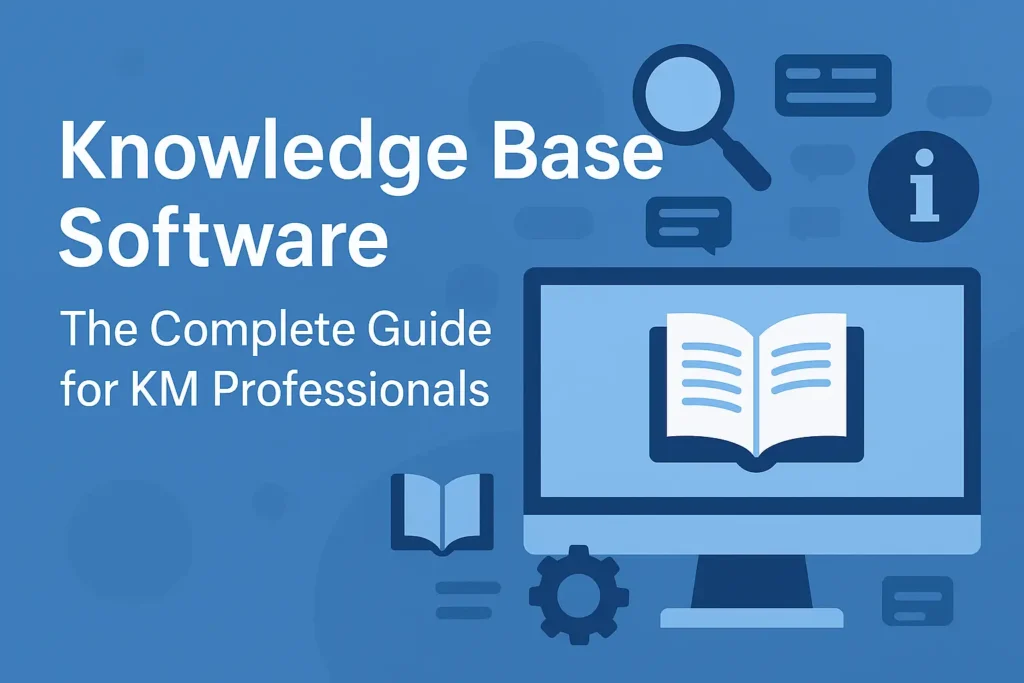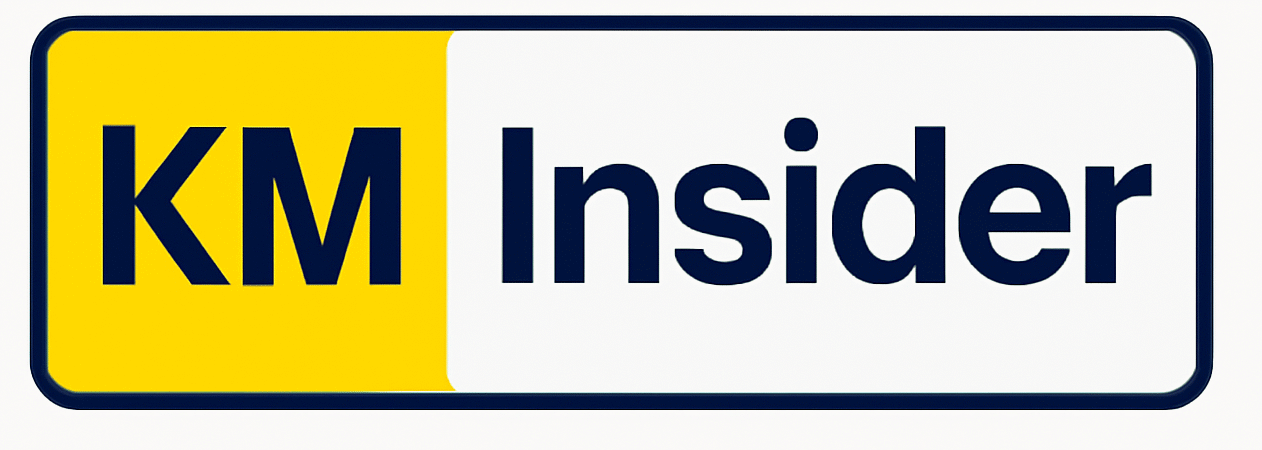A knowledge base is more than a library of articles. When done well, it becomes the nervous system of an organization — routing answers to customers and employees, reducing repeated effort, and preserving institutional memory. Choosing, building, and running knowledge base software is therefore both a technical and cultural challenge.
This guide covers everything: why Knowledge Base Software matters now, what modern systems can do, how to choose and implement one, measurements that prove value, and tactical guidance KM leaders can use to win adoption.

Why knowledge base software matters now
Three forces make knowledge base software a strategic investment:
- Rising customer expectation for instant answers. Customers prefer self-service for straightforward issues; good documentation is often the first touchpoint.
- Pressure to scale support without linear headcount growth. Well-run knowledge bases deflect repetitive tickets and free agents for higher-value work. Industry analyses show self-service initiatives deliver measurable ROI when executed well.
- AI and search improvements are making KBs more useful. Semantic search, automated tagging and AI assistants turn static articles into dynamic, conversational resources — increasing resolution rates and reducing search friction. Recent vendor and industry studies highlight this trend as a core differentiator for modern KB platforms.
Market signals back this up: the knowledge base software market is growing quickly, forecast to expand substantially in the coming decade — a clear sign organizations are investing in centralized knowledge tooling.
What modern knowledge base software does (capabilities)
Contemporary Knowledge Base platforms combine content authoring, discovery, governance, analytics, and integrations. Here are the capability areas that matter to KM professionals:
- Authoring & templates. WYSIWYG, Markdown, and structured templates for repeatable content (how-to, troubleshooting, SOPs).
- Powerful search. Semantic or AI-enhanced search that understands intent and surfaces relevant content even when users phrase queries differently.
- Content governance. Version control, review/approval workflows, ownership, and scheduled reviews to reduce content decay.
- Integrations. APIs and native connectors to ticketing systems, CRMs, chatbots, web widgets, and CMSs so knowledge surfaces in context.
- Analytics. Search terms, abandoned searches, article usefulness (thumbs up/down), and deflection metrics to prioritize work.
- Access & security. Role-based access, SSO, and enterprise compliance features for internal and external KBs.
- AI features. Auto-tagging, summarization, suggested articles for agents, and conversational UI layers (bots/assistants).
Leading vendor lists continue to evolve, but common names across reviews include Document360, Zendesk Guide, Confluence, Guru, Helpjuice, Bloomfire and others that cater to different use cases and scale.
Business outcomes you can expect
Well-executed Knowledge Base Software produces measurable outcomes:
- Ticket deflection / self-service success. Organizations routinely report that a clear, discoverable KB reduces repetitive tickets — studies show substantial cost savings when self-service works well. Exact deflection varies by industry and query complexity; AI and conversational layers can push deflection even higher in certain workflows.
- Faster onboarding and time-to-productivity. New employees get up to speed faster when institutional knowledge is searchable and curated.
- Higher agent productivity. Agents spend less time searching for answers and more time on high-value interactions.
- Improved product and process quality. Patterns in searches and debriefs reveal knowledge gaps that drive product fixes and documentation improvements.
Use these outcomes to define success metrics (below).
How to choose the right knowledge base software — a pragmatic checklist
Match tool capabilities to business needs. Use this decision framework:
1) Define primary use cases
- External self-service (customer-facing help center)
- Internal knowledge hub (agent enablement, HR, operations)
- Hybrid (both external + internal with different access controls)
2) Must-have feature list
- Semantic/intent search and relevance tuning
- Approval workflows and ownership fields
- Analytics (search queries, abandoned queries, article usage)
- Embeddable widgets and API for contextual surfaced answers
- Multi-language support if you operate globally
- Security: SSO, roles, encryption, compliance certifications
3) Evaluate buyer scenarios (SMB vs enterprise)
- SMBs: prioritize quick setup, low maintenance, ease-of-use (e.g., HelpJuice, Document360, Notion).
- Mid-market: seek integrations and analytics.
- Enterprise: require governance, SLAs, multi-brand support (Zendesk, Bloomfire, Guru, enterprise AEM/KM integrations).
4) Run vendor tests with real content
Don’t evaluate with vendor demo content. Import a sample of your articles, simulate search queries, and test article creation and workflow. Measure search accuracy, time-to-answer, and the editorial experience.
5) Total cost of ownership
Include migration, training, support, customizations, and API usage costs — not just license fees.
(See vendor comparisons and up-to-date lists for options and pricing.)
Implementation playbook — from pilot to scale
Phase 0: Alignment
- Stakeholders: product, support, KM, IT, legal, marketing.
- Goals: define top 3 outcomes (e.g., reduce repeat tickets by X%, increase self-service success to Y%).
- Inventory: map existing content sources and owner roles.
Phase 1: Pilot (4–8 weeks)
- Pick a domain (top 10 high-volume queries).
- Migrate 50–100 articles to the candidate KB.
- Configure search tuning, feedback mechanisms, and a simple workflow.
- Measure baseline metrics.
Phase 2: Iterate (2–4 months)
- Improve article quality using analytics (fix abandoned search terms, low-rated articles).
- Train agents to use the KB in their workflow; integrate with ticketing and chat.
- Introduce authoring templates and content ownership.
Phase 3: Scale & Govern
- Define content lifecycle: creation → review → publish → archive.
- Put dashboards in place: top searches, deflected tickets, article views, usefulness scores.
- Localize high-impact content; automate review reminders for stale content.
Phase 4: Continuous Improvement
- Use search logs and AI suggestions to identify coverage gaps.
- Run quarterly content audits and monthly “content sprints” to address top issues.
- Expand automated help (bots) for high-volume, low-complexity queries.
Content strategy & writing best practices (so articles get found and used)
Getting people to use your Knowledge Base depends on both taxonomy and writing quality.
- Answer the question up front. Use “short answer” then expand. This helps search snippets and reduces user effort.
- Use clear, scannable structure. H2s, steps, numbered lists, bolded key actions.
- Standardize templates. Title conventions, troubleshooting vs how-to formats, severity tags.
- Link to related content. Connect articles and surface next actions.
- Surface TL;DR. Executive summary for complex procedures.
- Make it canonical. Avoid duplicate articles covering the same question. Consolidate and redirect.
- SEO for KBs. Optimize for long-tail and question queries, use structured data (FAQ schema), and prepare concise answers that can be pulled into search engine answer boxes. SearchEngineLand and help-center SEO guides cover practical techniques for help centers.
Measurements that prove value
Pick a small set of leading and lagging indicators:
Leading indicators
- Search success rate (search → click → time on page)
- Number of thumbs-up / thumbs-down per article
- Abandoned searches (searches that return no results or no clicks)
- Agent article usage (how often agents reference KB articles in tickets)
Lagging indicators
- Ticket deflection rate (tickets reduced attributable to KB)
- Average handle time (AHT) for issues where KB is used
- CSAT on self-service interactions
- Onboarding ramp time for new hires
How to calculate deflection (simple model)
Track tickets before and after Knowledge Base launch for target queries. Deflected tickets × average cost per ticket = savings. Vendors and consultants provide calculators and frameworks to make this reliable.
Common pitfalls and how to avoid them
- Tool-first mentality — buying a tool without a content and governance plan.
Fix: Start with a content pilot and workflows before committing to heavy customization. - Poor discoverability — great content that users can’t find.
Fix: Invest in search tuning and semantic tagging; study abandoned search logs. - No ownership — content becomes stale.
Fix: Assign stewards and schedule review dates. - No integration with agent workflow — agents ignore the KB because it’s not in their console.
Fix: Embed KB content into ticketing and chat systems; show article suggestions contextually. - Measuring the wrong things — vanity metrics like raw article count.
Fix: Focus on engagement and impact metrics (deflection, search success).
The AI factor: What to expect and how to prepare
AI is not a magic shortcut, but it amplifies good processes:
- Auto-tagging & metadata generation. Reduces manual overhead and improves search. Research shows AI can meaningfully automate metadata generation and classification — key to scaling knowledge at large organizations.
- Semantic search & LLM assistants. Deliver better matches and answer synthesis; consider guardrails to avoid hallucinations.
- Content suggestions. AI can recommend articles to agents or propose drafts from ticket transcripts (requires solid editing workflows).
- Conversational interfaces. Chatbots that answer from the KB increase self-service but must surface source links to build trust.
Practical tip: Start with AI-assisted features (suggested tags, draft generation) and require human review. Monitor usage and accuracy before enabling fully automated responses.
Migration & consolidation checklist
If you’re consolidating many docs into one Knowledge Base:
- Inventory & classification. Audit all existing content and tag by owner, audience, and currency.
- Map canonical topics. Merge duplicate content into canonical articles; keep redirects.
- Prioritize high-impact pages. Move top-search and top-ticket articles first.
- Preserve metadata. Keep timestamps, authorship, and version history where possible.
- Redirect URL strategy. For public KBs, preserve SEO value with 301s and proper canonical tags.
- Train authors & agents. Run webinars, office hours, and simple documentation conventions.
Vendor shortlist & when to pick which one
- Document360 / HelpJuice / HelpScout: Quick to implement, strong for SMBs and mid-market self-service.
- Zendesk Guide / Freshdesk / Salesforce Service Cloud: Best if you need tight ticketing integration and enterprise support workflows.
- Confluence / Bloomfire / Guru: Strong internal collaboration and knowledge sharing for product and engineering teams.
- Specialized AI-first vendors: New entrants provide advanced semantic search and LLM-based agents — promising for aggressive automation, but vet for hallucination controls and auditability.
Always run a 4–8 week pilot with real content and real users before enterprise-wide rollout.
Days 0–14: Stakeholder kickoff, content inventory, choose pilot domain.
Days 15–45: Configure KB, migrate top 50 articles, embed search widget in agent console.
Days 46–75: Measure search logs, run content improvements, train agents.
Days 76–90: Expand to next domain, set governance cadence, publish dashboards.
Final advice for KM leaders
- Treat knowledge base software as a sociotechnical system: tool + content + people + measurement.
- Start with the most painful use case and demonstrate measurable wins (tickets deflected, AHT reduced).
- Combine human curation with AI assistance; keep humans in the loop for quality.
- Make discoverability a first-class feature — great content buried behind poor search is wasted effort.
- Iterate fast: measure, learn, and improve the KB continuously.
Sources & further reading
- ROI of self-service and case deflection — Zoomin framework and calculators.
- Top knowledge base vendors and comparison guides — Document360, HelpScout lists.
- Knowledge base SEO and help center optimization best practices — Helpcenter.io and Search Engine Land.
- AI and knowledge management trends — RapidInnovation and research on AI metadata management. Rapid Innovation+1
- Market growth and forecasts for knowledge base / KB software.
